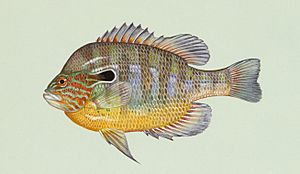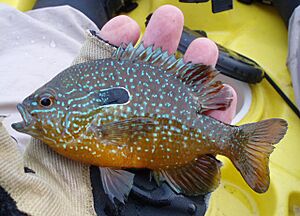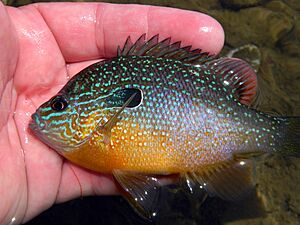Longear sunfish facts for kids
Quick facts for kids Longear sunfish |
|
|---|---|
 |
|
| Conservation status | |
| Scientific classification | |
| Synonyms | |
|
Icthelis megalotis Rafinesque, 1820 |
The longear sunfish (Lepomis megalotis) is a colorful freshwater fish. It belongs to the sunfish family, Centrarchidae. You can find it in eastern North America, from the Great Lakes all the way to northeastern Mexico. This fish can grow up to about 24 cm (9.5 in) long. It can weigh up to 790g (1.7 lb). Most longear sunfish live for about six years.
They have an olive to rusty-brown back and a bright orange belly. Their sides have cool blue-green bars on their heads. What makes them special is their long flap behind their eye. This flap looks like a "long ear"!
Longear sunfish like shallow waters with lots of plants. They live in lakes, ponds, and slow-moving streams. They eat insects, tiny water creatures, and small fish. They avoid strong currents. Male longear sunfish are great dads! They build and protect the nest. They even fan the eggs to keep them clean until the baby fish hatch. Some females can lay up to 4,000 eggs. They lay eggs in groups.
These fish are better at finding food in moving water than still water. This might be why you see more of them in streams than lakes. Longear sunfish are usually active during the day. They rest at night. Not many special efforts are being made to protect them. This is because they are still common.
Contents
Where Do Longear Sunfish Live?
Longear sunfish live in North America. You can mostly find them in the Mississippi River and Great Lakes areas. They prefer freshwater west of the Appalachian Mountains. Some populations are as far north as Quebec, Canada. They are also found as far south as central Mexico.
Their natural home is only on the North American continent. They are mainly found in the Mississippi and Great Lakes watersheds. You can also find them in the St. Lawrence River and Hudson Bay areas. This species has also been introduced to streams along the eastern coast of the United States.
The number of longear sunfish has stayed steady. This might be because they can travel through large bodies of water. This helps them avoid dams. They can also live in different types of water. This makes them strong against changes in their habitat.
What Do Longear Sunfish Eat?

Longear sunfish often feed near the water's surface. They are mostly carnivorous fish, meaning they eat meat. Their diet includes water insects and small crustaceans. They also eat fish eggs, young bass, and even young sunfish.
You might see them eating dragonflies and other insects. These insects fly over the water's surface. They also eat tiny bits of dead plants and animals. Other foods include gnat larvae, snails, day flies, and leeches. Adult longear sunfish eat mostly land insects, fish, and water insects.
Who Eats Longear Sunfish?
Largemouth bass, smallmouth bass, and wading birds are natural predators of the longear sunfish. Smaller longear sunfish can be eaten by larger sunfish. Sunfish are an important part of the food chain. They are both hunters and hunted animals in their ecosystems. Other sunfish and bigger fish compete with them for food.
Where Do Longear Sunfish Like to Live?
Longear sunfish are freshwater fish. They like streams with clear water and a firm clay or gravel bottom. They usually stay near aquatic vegetation. You can find them in streams of all sizes. They also live in lakes.
They prefer shallower, warmer parts of streams with a steady flow. They spend most of their time near water plants. They also hide in roots, brush piles, and undercut banks. This helps them stay safe from predators.
Sunfish do not like cloudy or muddy water. Human activities can harm their homes. Runoff from farms or cities can destroy water plants. These plants are important for the fish's safety. Chemicals in rivers can also change the water's pH. This can hurt the fish.
Longear Sunfish Life Cycle
Longear sunfish usually breed in late spring and early summer. This is from late May to late August. During this time, they are found in shallower, warmer waters. They like areas near stream pools.
Male longear sunfish build nests. They do this all by themselves. They prefer to build nests in gravel. But they can use sand or hard mud if needed. The male fish guards the nest during all stages of reproduction. A female can lay between 140 and 2,800 eggs.
After hatching, longear sunfish become adults in 2 to 3 years. Most live for 4 to 6 years in the wild. Some have lived up to 9 years! Longear sunfish cannot live in cloudy water. Their numbers have gone down in areas where streams became muddy. This mud can come from farming or industry. More human activity along rivers could continue to harm longear sunfish populations.
Longear Sunfish and People
Protecting Longear Sunfish
Longear sunfish are not currently endangered. They are not listed as threatened by federal or international groups. But people are still working to protect them. Small conservation actions are happening across the U.S.
They need clean water. So, controlling pollution from cities and farms is important. Pollution makes water cloudy. Losing their habitat also threatens them. This happens when shorelines are changed for farming. They prefer clear, shallow streams with water plants.
Mud and farm runoff also threaten them. This is why they have disappeared from some places. Longear sunfish are not in danger from too much fishing. This is because they are not a popular sport fish. They are also not considered very good to eat.
Longear sunfish are threatened in states like Wisconsin and New York. Special areas are being created in lakes and streams to protect them. These areas help the few groups of fish that live there. Since they are common in many places, big conservation groups are not taking major action. If human activities keep disturbing shorelines, their numbers might start to drop.
Fishing for Longear Sunfish
The world record for a longear sunfish caught by fishing is 0.79 kg (1 lb 12oz). This fish was caught in Elephant Butte Lake in New Mexico in 1985.
Images for kids






